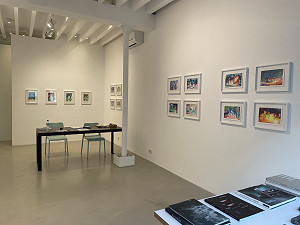Vlad Yurashko
WATERCOLOUR HONEY
You're cordially invited to the exhibition opening on Friday 09. February of at 6:00 p.m.

Wir freuen uns sehr, die erste Einzelausstellung von Vlad Yurashko in unserem Showroom in Palma ankündigen zu können.
Der ukrainische Maler, geboren 1970 in Poltawa, hat in seinen früheren Arbeiten immer wieder Bezug auf militärischeStrukturen und damit verbundenes Handeln genommen.
Insbesondere hat er sich intensiv mit seiner eigenen Zeit als Wehrpflichtiger, noch zu Zeiten der Sowjetunion, auseinandergesetzt. Seine Bildwelten waren geprägt von
autobiografischen und tagebuchartigen Situationen, die sich malerisch in dem Bereich von schwarz-weißen, Grau in Grau gehaltenen bis hin zu erdfarbenen und entsättigten
Farbspektren aufhielten. Die aktuellen Arbeiten in dieser Ausstellung mit dem Titel „Watercolour Honey“ sind weiterhin von dem aktuellen Kriegsgeschehen in seinem Heimatland geprägt, nun jedoch
bedient sich Yurashko im Gegensatz zu seinen füheren Arbeiten, einer neuen, farbenfrohen und fröhlicheren Farbpalette. Die abgebildeten Szenerien zeigen
märchenhaft idealisierte und traumartige Situationen, die einer Phantasiewelt zu entspringen scheinen. Auf diese Weise versucht der Künstler in seiner aktuellen Serie von Aquarellen, den Wunsch eines jeden Menschen
nach Frieden und Glück zum Ausdruck zu bringen, sowie der gegenwärtigen Situation in der Ukraine ein neues Narrativ entgegen zu setzen, das sich der Prägung von sich immer wiederholender Kriegsberichterstattung entzieht.